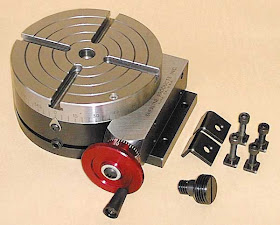There are many tools and accessories available for metal turning Lathes and Milling machines. Most hobbyist machinists will only require particular tools and accessories and only those made to suit the size of their machines and the scope of the work they are being used for. With accessories, bigger is not always better, weight is often a factor to consider, especially when all that weight is resting on your machine. Size can also be a factor when attaching the tool to your Lathe or Mill, be it by clamps or what ever means chosen.
The Rotary Table
For most machinists a rotary table will be an essential accessory. Usually used on a milling machine a rotary table allows work to be held securely and rotated around the tables spindle axis either during machining or between machining operations. Work can be attached in a variety of ways, directly to the tables face via clamps, via an attached chuck, be it 3, 4 jaw etc or by a collect chuck designed to fit into the tables spindle bore. The above table is a Vertex brand 4 inch (100 mm) HV table, weight 9kg.
Both tables pictured above are the style referred to as a HV or horizontal and vertical mount table. As the name suggests it can be mounted in both a horizontal fashion and vertical as shown above.
The table shown above is a tilting rotary table that allows work to be machined at an angle around the tables rotating axis. Many milling machines have the ability to tilt the machine head and so a tilting rotary table is often not needed. There are however some situations where both can be useful although for the added costs involved and the frequency of such an operation being used in a home work shop, most would not require a tilting table if the Milling machines head can be tilted.
One of the most important factors when considering a rotary table is the size of the parts being made and also how any particular size table will fit onto a milling machines table and can the machines work table support the weight of the Rotary table. Other factors are the tables centre height, the height between it's spindle centre and the table it's mounted on. For most hobby machine setups a 4 or 6 inch, 100 mm or 150 mm table is ample. The size denotes the diameter of the revolving table work is attached too.
In the picture above a 10 inch Vertex rotary table can be seen mounted in a desirable manner to a Milling machine. Note the bolt on the left securing the table via the Milling tables centre Tee slot. Another bolt, unseen is in a recess on the table right side. A setup like this is easy to attach, squareness is also easy to attain by use of a engineers set square against the milling table and right side of the table. The above table weighs 40 kg while the 100 mm version weighs 9kg. A 4 inch Vertex quality table can be purchased for around $300.00.
Another useful accessory to the rotary table is a tailstock. The tail stock allows a long part to be rotated between it and a rotary table while holding the work in a secure manner.
The above table is a 100mm Sherline brand rotary table, very well made with a weight of 3.6kg. This table is designed for horizontal use as pictured above though with the use of an angle plate can be used in a vertical setup.
Another feature of some but not all Rotary tables is a tapered spindle bore. Such a tapered bore allows the use of an ER collet chuck for example to hold smaller parts. An advantage of this setup is the collect chuck can be transferred between lathe and table etc without removing the part from the chuck and so maintaining accuracy. A tapered bore can also simplify mounting of some 3 jaw chucks.
Another feature of some but not all Rotary tables is a tapered spindle bore. Such a tapered bore allows the use of an ER collet chuck for example to hold smaller parts. An advantage of this setup is the collect chuck can be transferred between lathe and table etc without removing the part from the chuck and so maintaining accuracy. A tapered bore can also simplify mounting of some 3 jaw chucks.





